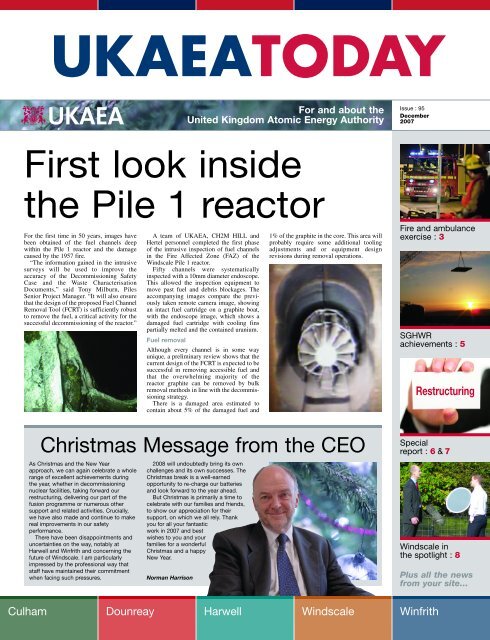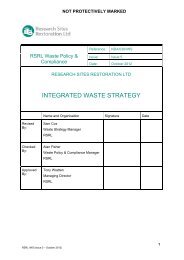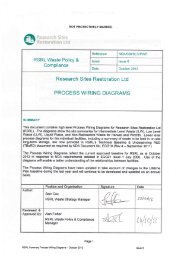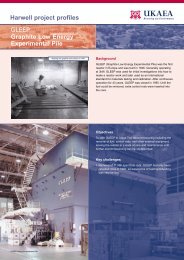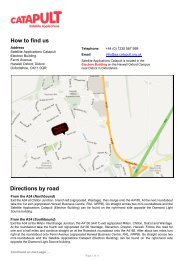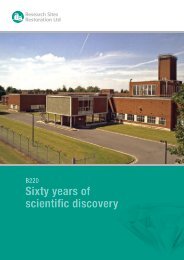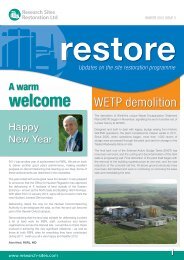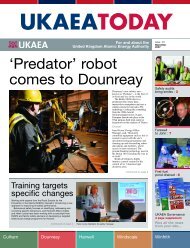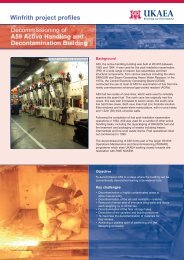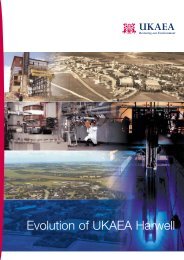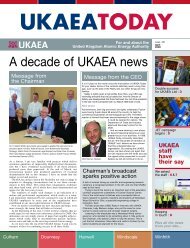UKAEA Today Dec 07.pdf - Research Sites Restoration Ltd
UKAEA Today Dec 07.pdf - Research Sites Restoration Ltd
UKAEA Today Dec 07.pdf - Research Sites Restoration Ltd
- No tags were found...
Create successful ePaper yourself
Turn your PDF publications into a flip-book with our unique Google optimized e-Paper software.
<strong>Dec</strong>ember 2007 <strong>UKAEA</strong>TODAY 3Safety, Health and EnvironmentEmergency services testedLightening the loadThis year’s European Week Lightenthe Load campaign was dedicatedto musculoskeletal disorders. Theweek ran from 22 to 26 October.Problems such as back pain andrepetitive strain injuries are the mostcommon form of ill-health disordersat work. Work-relatedmusculoskeletal disorders affectsome 1 million people in GreatBritain each year.The aim of the campaign was tosupport employers, workers, safetyrepresentatives and otherstakeholders in improving prevention.DounreayDounreay marked European Week forHeath and Safety with a programmeof events including yoga sessionsand lunchtime walks, presentationson electrical safety, and a safetyexhibition. The week ended with theannual safety quiz in support ofBreast Cancer Awareness.Oscar the robot, sponsored by Alstecmade his annual visit.Oscar called on four local primaryschools to promote road, home, railand water safety. He found a warmreception from the children at MountPleasant School, Pennyland PrimarySchool, Castletown Primary Schooland Halkirk Primary School.The Dounreay Fire & AmbulanceService held a joint exercise withthe Highlands & Islands Fire &Rescue Service recently.“It was a good opportunity forboth fire services to role-playtogether,” said Dounreay’s FireChief, Kenny Porteous. “Theexercise highlighted theimportance of making efficient useof our limited resources. Byholding these exercises, we canmake our joint operations aseffective as possible.”The scenario for the exercise,which took place on the site duringthe evening of 11 October, centredon an administration buildingbeing prepared for demolition.Emergency personnel were calledout to deal with a simulatedexplosion and fire, and rescue‘casualties’ from inside the smokefilledbuilding.Each school received £250 from<strong>UKAEA</strong> for participating. Theschools were also invited to enter acompetition to draw a newcharacter for Alstec’s children’ssafety book. The winning school willreceive £500 from Alstec.HarwellHealth and safety events to markthe Week on the Harwell site tookthe form of advice and guidanceroadshows, organised inconjunction with Capita. A safetyquiz and other competitions werealso held. Staff commented that thetopic area was of interest because itcovered a wide range of taskscarried out by both office-basedand operational staff.Pupils from Mount Pleasant School with Oscar during his visitThirty-two personnel and five fireappliances were involved and theexercise was observed bymembers of Dounreay’s EmergencyArrangements team and Fire &Ambulance Service, and bymembers of the Highlands &Islands Fire & Rescue Service(HIFRS).The exercise tested the HIFRS’sincident plan for the Dounreay siteand the interaction between thetwo services.Gareth Edwards, HIFRS AreaManager, commented, “This was aworthwhile exercise and will act asa template for future exercises toensure an efficient and coordinatedresponse from bothorganisations to any siteemergency.”The exercise was considered tobe a successful demonstration ofthe two services working together.Recyclingrates doubleIn the last four years, the volume of wasterecycled at the Harwell site has more thandoubled.In 2003, the Harwell site produced inexcess of 90 tonnes of non-radiologicalwaste. Although some of it was recycled,much of it ended up in landfill. Since the2004 initiative to increase the amount ofwaste recycled, the picture has been transformed.Increasing recycling rates not onlybenefit the environment, they help decreasecosts associated with other disposal routes.With the assistance of waste broker ISSFacilities Services <strong>Ltd</strong> and waste carrierGrundon’s, <strong>UKAEA</strong> has increased the rangeof items that can be recycled, improvedcollection facilities and run an awarenesscampaign to encourage recycling.Items such as coloured paper, stationery,business forms, computer paper, cardboard,newspapers, magazines, telephone directories,books, plastics and drink cans can nowbe recycled, leading to the present 200%increase in the volume of waste recycled.Still more could be done, however. It isestimated that 90% of all office waste couldbe recycled. Although Harwell is movingtowards this figure, we need your help tomeet that target. Please make sure that youput all recyclable wastes in the appropriatebins and keep routine waste to an absoluteminimum.League tableAs part of its drive to boost recycling,Harwell Facilities Management is setting upa recycling league table. From our records,we can tell how much waste each individualbuilding on site produces. We will becontacting buildings to let then know howwell they are doing in relation to otherbuildings on site You can check your building’srecycling rates and help make yourbuilding top of the league by recyclingmore.Christmas card recyclingAs in previous years, staff at Harwell will beable to support the Woodland Trust ChristmasCard Recycling Scheme. Once the festivitiesare over, bring in your old Christmas cardsand leave them in special collection points.In the three years <strong>UKAEA</strong> have beensupporting this cause, the volume of cardshas increased by 300%. More than 220kg ofcards were recycled last year. For moreinformation visit http://www.woodlandtrust.org.uk/index.htmLarge and smallRecycling services are also available forbigger items, such as large quantities ofbooks, cardboard, glass and – in line withthe recent Waste Electrical and ElectronicEquipment (WEEE) Directive – IT, telecomsand electrical equipment. Collections can bearranged by contacting the Helpdesk on01235 43 3000. Smaller items such asbatteries and toner cartridges can be sentdirect to ISS in B404.Find out more information about theHarwell waste routes by visiting:http://harwellwinfrith.intranet/upload/harwell/doc/Waste.doc
4<strong>UKAEA</strong>TODAY <strong>Dec</strong>ember 2007Harwell ■ International conference ■ LETP ■ Computer modelling ■ Chilton School ■ Relay marathonNEA membershead for HarwellAlan Neal with Ivo Tripputi of SOGIN<strong>UKAEA</strong> recently hosted the Nuclear Energy Agency WorkingParty on <strong>Dec</strong>ommissioning and Dismantling conference, 7- 9November. Members included operators and regulators fromEurope, Asia and North America, who meet once a year toreview process and decommissioning projects.“It was an honour to welcome colleagues from across theworld to Oxfordshire,” said Harwell Head of Site Alan Neal.“The conference was a great success and has helped toenhance <strong>UKAEA</strong>’s reputation internationally.”In total 30 delegates visited for the three-day conference,which was held at the Milton Hill Conference Centre. On theFriday morning they were shown the Harwell site and thedecommissioning progress being made there, along withvisiting B462 waste stores, DIDO and B459 active handlingbuilding.A race in four partsA Harwell/Winfrith team ofMichelle Wise, Gail Steer, AlanNeal and Andy Staples tookpart in the Clarendon RelayMarathon on 30 September.Each ran over six miles betweenSalisbury and Winchester tocomplete the race.Michelle Wise ran the firstleg. “My part of the course wasalmost completely uphill. Thetracks were narrow and slippybut the views were amazing.”Michelle handed over to Gailwho ran an undulating sectionwith some “deep gullies eitherside of very narrow paths,which definitely focused themind!”Being the fastest of the four,Alan ran the third leg, thelongest at 7.5 miles. “I justcarried on running as hard as Icould, hopingthat Andy wouldbe there for thechangeover, ashe’d travelled tothe venueseparately,” hesaid.Fortunately,Andy did make itto thechangeover pointin good time andAlan, Gail andMichelle met upto watch him run home.Just over four hours after thestart, Andy appeared headingstrongly for the finish butcovered in blood. “I wasrunning flat out on the finaldescent when I slipped andheadbutted the ground,” heexplained. Though he had cutsto his face, arms and knees, hemanaged to finish and, after aquick bandage from the StJohn’s Ambulance, was able togo and collect his well-earnedmedal.“Given the circumstances,we were content to havefinished in a time of 4 hours 3minutes but annoyed to be justbeaten by Didcot PowerStation,” said Alan. “Hopefully,our efforts will inspire otherteams to enter for next year.”Innovative thinkingsaves £1 millionThe determination of staff atHarwell’s Liquid EffluentTreatment Plant (LETP) hasled to a significant reduction inthe volume of waste being sentfor storage at the nationalrepository.Using innovative methods,the team have been able toreduce the number of low levelwaste (LLW) containers bymore than 30 – saving thecompany some £1 mllion.The latest phase of theB336.3 decommissioningproject involved the segregationof over 300 tonnes of‘exempt waste’, which can besent to landfill, rather than thetraditional route of Drigg, aswould most certainly havehappened in the past.This equates to approximately18 Half Height ISO(HHISO) containers, on top ofthe 15 HHISOs already savedon the demolition of the buildinglast year. The latest savingsresulted from the use of aninnovative device called an InSitu Object Counting System,or ISOCS.Waste is loaded into onetonne builders’ bags andplaced on a turntable where agamma spec monitor surveysFlask passesperformance testDeformation behaviour: above, at the start of theimpact event and, below, at the endeach bag over a 15 minuteperiod, to make sure the wasteis exempt and can be disposedof to landfill.Learning opportunity“Traditionally this type ofwaste would have to be sent asLLW due to the history ofwork on the LETP site. Thismethod has enabled a significantreduction in waste thatwill be sent to the nationalrepository at Drigg,” saidProject Manager Dave Wilkins.“A review of a previousproject at the LETP suggestedthat large savings could be madeif better monitoring equipmentwas available. We took thelearning opportunity andadapted it for this project, whichExempt waste is checkedhas paid dividends,” he added.It is not the first time theISOCS has been used atHarwell. It was employed onthe Southern Storage project afew years ago. This again ledto large reductions in wastevolumes.The project was managed by<strong>UKAEA</strong> with support from theprincipal contractor H Smith,NUKEM (who supplied theISOCS equipment) and inhouseoperator resource whoprovided invaluable support inwaste processing.The total waste cost savingon the B336.3 project is inexcess of £1 million, and thelessons learnt on this projectwill result in significantsavings in the future.Graviner flasks in various forms have beenused for decades in the nuclear industry, on theHarwell site.A recent evaluation, as part of the re-licensingof the flask for continuing service, wascarried out by Arup, on behalf of <strong>UKAEA</strong>, toensure this form of containment continues toperform satisfactorily. The vertical loadingflasks are used to transport radioactive materialsin sealed cans between buildings on theHarwell site.The review took the form of a finite elementcomputer simulation, rather than an actual dropaccident test, and the results were presented atthe 15th International Symposium on thePackaging and Transportation of RadioactiveMaterials (PATRAM) in October.“We decided to use finite element analysis ofthe flask for the testing,” explained GaryJordan, <strong>UKAEA</strong> Package Custodian. “Thisgave us a good understanding of its behaviourand a more thorough evaluation of its impactperformance than actual drop tests couldprovide. This technique also has the advantagethat, once a mathematical model has been built,additional drop scenarios can be easilyanalysed and design modifications incorporated,if needed.”The work demonstrated the computermodelled behaviour of the flask in varioushypothetical accident conditions and concludedthat it would perform satisfactorily. Based onthe analyses, the Nuclear InstallationsInspectorate granted continued operation for afurther two years.
<strong>Dec</strong>ember 2007 <strong>UKAEA</strong>TODAY 5CEO visitsWinfrith ■ Celebrating decommissioning achievementsListening tostaff views<strong>UKAEA</strong> CEO Norman Harrison made informalvisits to Harwell and Winfrith during November.These ‘walkabout sessions’ enabled him to meetstaff and listen to their views on the recentfunding restrictions and the consequential effecton jobs.Assessment of the second round ofapplications under <strong>UKAEA</strong>’s voluntary earlyrelease scheme is due to be completed by theend of November. Once this stage is complete, itwill be clear if sufficient applications have beenreceived and accepted to enable revised workprogrammes across the two sites to beimplemented, or if consideration will need to begiven to possible compulsory redundancies.“I thought it was important at this very difficulttime to hear the views of some of the membersof staff directly involved,” said Norman. “I thankthem for taking the time to share their open andhonest comments with me.”Sheddingsome light<strong>UKAEA</strong> Harwell, in conjunction with Scion,came to the rescue of Chilton Schoolrecently when the school’s street lightingstopped working. An engineer in a ‘cherrypicker’ soon had the problem sorted.SGHWR factfileOverviewBuilt in the 1960s, Winfrith’s Steam Generating HeavyWater Reactor (SGHWR) first began sending power tothe National Grid on Christmas Eve 1967.The largest of the nine experimental reactors housedat the Dorset site, SGHWR was operational for 23 yearsuntil it was shut down in 1990, when it was put intolong-term care and maintenance. In 2005, work todecommission it began.One of the features of the reactor was that it was adirect cycle type, which meant that the radioactivesteam generated in the reactor went directly to theturbine thus contaminating it, and many of itsassociated systems.Over two years, the project team dealt with andovercame some testing challenges, including theremoval of large amounts of contaminated material andthe removal of asbestos from many areas. During theperiod, some 250 separate rooms and areas weredecontaminated and de-planted. Several huge items ofcontaminated equipment, such as the rotating shieldsand the steam turbine, were dismantled and removed.Facts and figures• Steam turbine-alternator – comprised many largeitems weighing in total about 510 tonnes. In order to fitthese items into ISO containers most had to be sizereduced, either by diamond wire sawing or hot cutting.• Condenser – contained over 12000 copper tubes andweighed in total about 261 tonnes. It was cut up in situusing oxy-acetylene cutting equipment.• Reactor fuelling machines – two refuelling machines,one weighing 37 tonnes and the other 185 tonnes. Theywere dismantled and/or cut up in situ. Many pieces hadto be size reduced to fit into ISO containers.• Feed heater cell – there were four heaters, variousdrains vessels and several hundred metres of associatedpipes of varying diameters. All the waste,weighing 160 tonnes was size reduced for disposal inISO containers. 3.5 tonnes of MMMF insulation wereremoved and disposed as LLW. Walls, floors andceiling were decontaminated, an area of 1200 m2.• Rotating shields – there were two rotating shields, onesitting inside the other. The inner shield weighed 96tonnes and the outer shield 311 tonnes. Theycontained shielding in the form of polypropylenebeads, lead and iron shot. The shields were removedand size reduced for disposal. The hole into theprimary containment was resealed using concretebeams.• A total of 3106 tonnes of waste was removed,comprising 663 exempt waste and 2443 LLW.• 90 people were involved, 10 staff and 80 contractors.Safety recordThe decommissioning team worked with a variety ofcontractors to achieve continuous improvements insafety. The SGHWR project team pioneered theintroduction of Behavioural Safety at Winfrith.Care & Maintenance – What’s involved?In the immediate future, the SGHWR project is movinginto a Care & Maintenance phase for an indefinite period.Although there will be no decommissioning going on,there are several systems in the facility that are stillrequired. For example the ventilation system, theelectrical distribution system and the active drains.As decommissioning will restart sometime in thefuture, items such as the 60 tonne crane will be neededagain, so will have to be maintained, regularly inspectedand kept operational.The fabric of the building is subject to all weatherconditions and will need to be maintained to ensure theintegrity of the secondary containment.Looking aheadUltimately, the next stage in the project will be to tacklethe equipment in the primary containment building andthe 350 tonne reactor core itself. In this highlyradioactive environment, remotely controlled machineswill be used for the decommissioning work. Once that iscompleted, the whole building will be demolished andthe area landscaped and laid to grass.<strong>UKAEA</strong> Project Manager Kevin McIntyre comments,“When funding allows, plans are in place for taking thecore apart, de-planting the primary containment andconstructing a new ILW processing facility, where wasteswill be packaged ready for sending off-site to storage.“However, with the SGHWR team now disbanding, aspart of the significant redundancies across the Winfrithand Harwell sites, the timetable for this phase of theproject remains uncertain.“As the SGHWR moves into Care & Maintenance,everyone involved in the decommissioning can lookback with satisfaction over three years of innovative andsuccessful work which, despite its unprecedentednature, was completed to time and budget, and with nosignificant safety events. We can all be proud ofeverything we have achieved.”
6<strong>UKAEA</strong>TODAY <strong>Dec</strong>ember 2007Changing placesThe way <strong>UKAEA</strong> is managed is changing. <strong>UKAEA</strong> <strong>Today</strong> examines theNUCLEARDECOMMISSIONINGAUTHORITY (NDA)SITE LICENCECOMPANIES(SLCs)What isthe NDA?The NDA is a non-departmental public body of the Department for Business,Enterprise and Regulatory Reform. It is responsible to Government for thedecommissioning of 20 sites in the UK. This is funded through a mixture oftaxpayers’ money and income from facilities still operating, such as electricitysales.Why was it set up?The Government believed decommissioning Britain’s redundant nuclearfacilities needed a new sense of direction at a national level. It wanted to seea national strategy put in place and competition to deliver the strategy moreefficiently than before.Who runs the NDA?Directors are appointed by Government. They include non-executive directorsand executive directors who are full-time employees.What is its role at <strong>UKAEA</strong> sites?Each year, site decommissioning contractors, including <strong>UKAEA</strong>, prepare alifetime plan, showing all the work needed to complete the decommissioning,when it will happen and how much it will cost.The NDA decides the level of resources to be made available to each site,giving priority to the reduction of the greatest hazards.The NDA matches up available resources to the work in the plan so that afunded programme for the next year can be agreed. It attaches a series ofperformance measures to the agreed programme. If a site meets these measures,the NDA pays a fee to the operator. This is the operator’s profit on the contract.So who is in charge of <strong>UKAEA</strong>’s sites?The holder of the licence granted by the Nuclear Installations Inspectorate isin charge of the site. This is <strong>UKAEA</strong>. <strong>Dec</strong>isions about the day-to-day operationof the site are matters for <strong>UKAEA</strong>.What has it achieved?By April next year, NDA will have established for the first time the total lifetimecost to the UK Government of decommissioning every redundant nuclear facility.Latest estimates put the cost at £70 billion. It will have overseen the formation ofnew site licence companies to enable competition to begin for its sites.This competitive approach has already seen the estimate fordecommissioning <strong>UKAEA</strong> sites reduce. In the last two years, the NDA reckonsto have achieved savings of £330 million to the taxpayer.Why are sitelicence companiesbeing set up?Until now, decommissioning of redundant civil nuclear sites in the UK hasbeen carried out by BNG or <strong>UKAEA</strong>. The Government wants to give privatecompanies the chance to compete for this work. Therefore the 20 sites needto be repackaged as individual sites or bundles of sites.The existing BNG or <strong>UKAEA</strong> workforces at each site, their programmes ofwork, the site licences and other authorisations will be transferred to one ofseven new companies being set up.These new site licence companies will have the contract with the NDA todecommission that site, or bundle of sites, sometimes called a Tier 1 contractor a Management and Operation contract.When does this happen?<strong>UKAEA</strong> has begun to organise its site activities so they can operate asseparate site licence companies. New companies have been registered, in theform of Dounreay Site <strong>Restoration</strong> <strong>Ltd</strong> and <strong>Research</strong> <strong>Sites</strong> <strong>Restoration</strong> <strong>Ltd</strong>.The next step is to test the new arrangements during a period of shadowworking. At Windscale and Dounreay this started at the end of October. If itproves successful, all the existing <strong>UKAEA</strong> functions at Dounreay will transferformally to the new company, DSRL, on 1 April, 2008 and Windscale willbecome part of the Sellafield <strong>Ltd</strong> site licence company.Harwell and Winfrith are expected to start shadow working in February2008, with the formation of RSRL following in August.Who will be in charge of the site from April 1, 2008?The same people who are in charge during shadow working. Althoughemployed by <strong>UKAEA</strong> <strong>Ltd</strong>, the senior management will be seconded to thenew site licence company and work as part of that company.The senior management will be accountable to a new board of directors.Who will be responsible for safety and environmental protection?Exactly the same people who are responsible now – everyone working on thesite. In addition, the local safety and environment teams, the regulators, the NDAand the stakeholder group will continue to operate as they do at the moment.What does this mean for staff being transferred to the site licence companies?Staff being transferred will notice no difference in their terms and conditionsas employees of the new company, and will have protection under the TUPEregulations. The NDA is setting up a new pension scheme, and has givenassurances that the terms will be no less favourable than at the moment.
<strong>Dec</strong>ember 2007 <strong>UKAEA</strong>TODAY 7role of the various entities involved.<strong>UKAEA</strong> LTDTHE ALLIANCEWhat is<strong>UKAEA</strong> <strong>Ltd</strong>?This is a company being formed by the UK Atomic Energy Authority tocompete for new business.Why has it been set up?It’s part of the Government’s wish to create a competitive market for thedecommissioning of redundant nuclear sites. This entails breaking up muchof <strong>UKAEA</strong> and BNG into smaller units – site licence companies like DSRL andRSRL.UK and overseas companies are interested in bidding for these site licencecompanies. <strong>UKAEA</strong> saw an opportunity to use its skills and expertise to forma new business to compete with these other companies and, with thesupport of the then DTI, decided to form <strong>UKAEA</strong> <strong>Ltd</strong>.Who owns <strong>UKAEA</strong> <strong>Ltd</strong>?<strong>UKAEA</strong> <strong>Ltd</strong> will start life as a wholly-owned subsidiary of the UK AtomicEnergy Authority, a non-departmental public body of the Department forBusiness, Enterprise and Regulatory Reform. Its success is expected to leadto a gradual transition to the private sector.How many people will it employ?About 150-200 people will transfer to <strong>UKAEA</strong> <strong>Ltd</strong> on April 1, 2008.What will they be doing?<strong>UKAEA</strong> <strong>Ltd</strong> will own DSRL and RSRL. Some of its staff will be seconded tomanagement positions in these companies. <strong>UKAEA</strong> <strong>Ltd</strong> will continue to ownthese site licence companies (SLCs) until competition.<strong>UKAEA</strong> <strong>Ltd</strong> can compete for contracts let by the SLCs (often called Tier 2or 3 contracts) as well as those being let by the NDA. It is also pursuingsimilar work with other customers in the UK and abroad, often in alliance withother companies.<strong>UKAEA</strong> <strong>Ltd</strong> will also own the pensions administration unit in Thurso.And <strong>UKAEA</strong> <strong>Ltd</strong> will bid for the site licence companies when the NDAputs them out to tender?Yes, as part of an alliance with AMEC and CH2M HILL.What isthe Alliance?The Alliance is the working name of an agreement between <strong>UKAEA</strong> <strong>Ltd</strong> andtwo companies – AMEC of the UK and CH2M HILL of the USA – to worktogether. Under this agreement, the two companies support the work of<strong>UKAEA</strong> at its sites.Why was it formed?<strong>UKAEA</strong> wanted to improve its delivery of decommissioning work to the NDAand to compete for future contracts to run sites. While <strong>UKAEA</strong> had expertise,particularly in technical areas such as waste management and site licensing,there was a need to strengthen its position in other areas. Following acompetitive tendering exercise, <strong>UKAEA</strong> chose AMEC and CH2M HILL.Why those companies?AMEC has a strong background in project management and is growing itsinterests in the energy sector. CH2M HILL has an international pedigree intaking redundant nuclear sites through to final closure.Who’s in charge?The Alliance companies are not but, where individual managers are secondedinto management positions at <strong>UKAEA</strong> sites, they are in charge of theirrespective areas. <strong>UKAEA</strong> continues to be responsible for all site activities andthis will remain the case up to competition. The staff seconded from AMECand CH2M HILL are supporting <strong>UKAEA</strong>.Will all three companies be bidding for<strong>UKAEA</strong> sites separately or as one?As one. The Alliance will form a new company which will be the body thatbids for contracts from the NDA. They have already formed the PentlandAlliance to bid for the Dounreay contract.What happens when they win contracts?The new body will take over ownership of the site licence company. It willsecond staff into senior positions to drive forward the management, prettymuch as is happening at the moment. The difference is that <strong>UKAEA</strong> <strong>Ltd</strong> willown a share of the company along with AMEC and CH2M HILL, rather thanthe 100 per cent it owns in the run-up to competition.
8<strong>UKAEA</strong>TODAY <strong>Dec</strong>ember 2007Dounreay ■ DFR dome ■ Janetstown facility ■ PFR ■ Nuclear Academy ■ PFR plansStripping out ofdome beginsTrials centrehelps clean-upprogrammeThe work to remove the innards of Dounreay’s famous domehas begun. The integral reactor ducting and associatedequipment that once helped power the UK’s first fast breederreactor have been stripped out.The reactor well ventilation ducting and some electromagnetic pump ductwork are being removed to open upaccess routes for the removal of the DFR breeder. Essentialsafety checks are being carried out before the ducts can becut into manageable sections. A total of 85 metres ofredundant ducting will then be wrapped and placed in storage,to await packaging and disposal as waste.By using embedded contractor support, <strong>UKAEA</strong> has beenable to keep costs down. An incentive scheme will reward theteam for carrying out the work to cost and on schedule – whilemaintaining an exemplary safety record. The removal of theductwork is estimated for completion by the end of March2008.A redundant glovebox is also to be removed. The gloveboxwas installed within the sphere for the removal of equipmentassociated with the reactor primary coolant circuits. Removalwill free up space and allow the unit to be used elsewhere onsite, saving time and a substantial amount of money.Once the glovebox has been isolated and checked for saferemoval, it will be lifted from the plant using the newlyrefurbished Goliath crane. It will then be prepared fortransportation to the Prototype Fast Reactor facility where itwill be used as part of their decommissioning programme.Mike Brown, DFR decommissioning manager, said,“Removing old equipment that has been in situ for over 50years brings with it many challenges. Lateral thinking andexpert planning are essential and safety must remain theutmost priority at all times.“The project team are delivering an optimised programme ofwork which is not only essential for the decommissioning ofDFR but brings with it benefits to the overall sitedecommissioning programme and other plants and facilities.”<strong>UKAEA</strong> is carrying out this work on behalf of the Nuclear<strong>Dec</strong>ommissioning Authority with the support of its contractorsDoosan Babcock, Nukem and Johnson Controls.The decommissioning of DFR is expected to take up to theyear 2030 to complete.The purpose-built trials andtest facility at Janetstown onthe outskirts of Thurso is beingused to remove bulk sodiumfrom a range of vessels.Radiologically clean sodiumis removed by digging out thesolid sodium metal, using handoperated electric power tools.The sodium is then repackedinto steel drums for transportationto a commercial hightemperature incinerator, whereit is destroyed.Brad Smith, Site ProjectManager, said, “TheJanetstown facility is anextremely valuable resourcefor the site’s decommissioningprogramme and allows essentialtrials to take place in arealistic and safe workingenvironment.“The removal of the sodiumpresents a unique challenge tothe PFR project team.<strong>UKAEA</strong> and its contractors areworking together to developnew techniques for theremoval of the Dounreay FastReactor’s liquid metal coolant.Safe destruction of thesehazards is crucial as weprepare to dismantle the site’sformer reactors and associatedequipment.”Pioneering techniqueThe Janetstown facility wasinitially established to developthe pioneering Water VapourNitrogen (WVN) technique forthe safe destruction ofDounreay’s alkali metal.Further WVN operations arebeing considered for handlingsodium containing pyrophoricmaterial such as sodiumhydride. It may also be used totrial development techniquesfor the destruction of thesodium-potassium liquid metalcoolant used in the DounreayFast Reactor.The work is being carriedout on behalf of the Nuclear<strong>Dec</strong>ommissioning Authority bythe AMRR Alliance, withcontractor support from Alstec<strong>Ltd</strong>, JGC Engineering &Technical Services <strong>Ltd</strong> andJacobs.The current programme ofwork was scheduled forcompletion by March 2009but, due to successful planningand operation, it is now anticipatedthat it will be completednext year.Key milestonefor new wastehandling facilityDounreay has received authorisation from regulators tobegin active commissioning of a newly constructedwaste handling facility.Permission to proceed with active commissioningwas granted following a period of inactivecommissioning. This confirmed the as-built facility metdefined plant performance and functional requirementsand also achieved compliance with the facility safetycase.Costing £10 million to construct, the facility willincrease the site’s capacity for storing solidintermediate level waste from the clean-up anddemolition of the fast reactor experiment.John Swanson, Senior Project Manager, said, “Thisis a key milestone which marks the successfulcompletion of the project. The project team haveworked hard to achieve delivery safely, on time andwithin budget.”Operational personnel will now carry out activecommissioning, with the plant expected to commenceroutine operation in early 2008.The waste facility is an essential element indecommissioning Dounreay. It will increase the site’scapacity for the storage and management of solidintermediate level waste from the decommissioningprogramme and optimise the functionality of theexisting cementation plant and store.
<strong>Dec</strong>ember 2007 <strong>UKAEA</strong>TODAY 9Culham ■ Advisory panel ■ Café Scientifique ■ Charity climbHeavies removedfrom reactorDounreay’s Prototype Fast Reactor (PFR), which once fedpower into the national grid, is undergoing a massivetransformation. Huge heat exchangers, evaporators, pumpsand expansion tanks, which once formed an integral part ofthe reactor’s secondary sodium circuit, have been removed aspart of the site’s decommissioning programme.This £1m project is major progress for PFR. The projectinvolves the strip-out of the steam generating building and thethree secondary sodium circuits, and the removal ofassociated redundant plant and equipment. To-date over 700tonnes of disused steel items have been stripped out of theplant for disposal.Carrying out the removal of the latest heavyweights is thePFR project team led by Rashid Abdulla, with support from<strong>UKAEA</strong>, NUKEM, Baker Dougan and Caithness Scaffolding.“Due to the diligence of the team, this decommissioningwork has been completed with a perfect safety record,” saidPFR <strong>Dec</strong>ommissioning Manager Jim McCafferty. “This hascontributed to the PFR project achieving over 1,000 days,equivalent to 1.4 million man hours, without a lost timeaccident – an outstanding safety performance.”Brad Smith, Site Project Manager, added, “This is anothermilestone in the restoration of the Dounreay site on behalf ofthe Nuclear <strong>Dec</strong>ommissioning Authority. Removal of theobsolete and hazardous equipment from our plants is crucialto enable the decommissioning programme to proceed safelyand on schedule.”International advisorypanel meets for first timeThe growing scale and influenceof the MAST SphericalTokamak research programmehas led to the setting up of aninternational advisory panel ofinfluential fusion scientists,called the MAST ProgrammeAdvisory Committee (PAC).The focus of the panel,which had its inauguralmeeting at Culham in midOctober, is to advise on allaspects of the MASTprogramme and the forwardstrategy. It is chaired byProfessor Chris Schüllerfrom the FOM fusion institutein the Netherlands, whois also a member of theEPSRC’s Fusion AdvisoryBoard.“The views of the PAC areparticularly important now aswe begin discussions on thenext grant from the EPSRCand the funding of theproposed major upgrade ofMAST,” said William Morris,Manager of the ExperimentsDepartment. “We are alsoCappuccino with an extra shot of fusionHow do you fancy hearing all about fusion over acup of coffee? With Café Scientifique, you can.Café Scientifique is a group of people whoorganise informal forums to discuss scienceCulham’s Chris Carpenter discusses fusion at the CaféScientifique, Oxfordpreparing for the majorEuropean Fusion FacilitiesReview which is to look at thefusion programme in Europeover the next 20 years andbeyond.”After some very positivecomments on the quality andimportance of the MASTresearch, the PAC made anumber of thoughtful recommendations,in particular onthe balance of the two mainareas of the research.These were:• unique contributions totokamak physics in preparationfor ITER operation andthe design of the futuredemonstration fusion powerplant (DEMO)• work to establish the physicsbasis for a Component TestFacility based on the sphericaltokamak, which willcontribute vital data towardsthe development of a fusionpower plant.PAC members in the MAST area, where the engineering break allowedthem an unusual opportunity to see the interior of the tokamak.topics. Scientists and members of the publicare able to enter into an informed debate overa skinny latte or a frothy cappuccino.“I’m a fan of Café Scientifique evenings,because there’s no Powerpoint or visual aids.You just talk to the audience and see whereyou get to – it’s fun,” said Culham’s ChrisCarpenter.During the last year, staff from Culham haveparticipated in events at Croydon, Bath,Portsmouth and even Egypt, by videoconference. Most recently, Chris provoked arange of well-considered questions anddiscussions about fusion power at Café Neroin Blackwells, Oxford.For more information visit:http://cafescientifique.org/http://www.cafesci.org/oxford/Consortium for nuclearskills academyThe newly formed National Skills Academy Nuclear hasselected a consortium consisting of four Scottish colleges todevelop and implement a range of Higher National Diplomasfor Scotland’s nuclear employers.These important new qualifications will support progressionand development opportunities in the nuclear sector for schoolleavers, new entrants and those re-training. The group is beingled by North Highland College (Thurso) supported byKilmarnock College; Dumfries & Galloway College andGlasgow College of Nautical Studies.The National Skills Academy Nuclear is an employer-ledskills and training initiative, developed to meet the needs ofemployers across the UK nuclear industry.On top of the worldAfter an exhausting five-day climb, Culham PhDstudent Melanie Windridge recently reached thesummit of the highest peak on MountKilimanjaro, Uhuru.At 5,895m, Kilimanjaro in Tanzania is the tallestfree-standing mountain in the world and thehighest which can be trekked up without the aidof climbing equipment.Melanie’s achievement raised over £2,000 forEdrisa UK and was supported by a donationfrom the Culham Sponsorship Fund. Edrisa UKsupports local health, education and agriculturalprojects in Uganda.At the summit of Kilimanjaro. Melanie is third left
10<strong>UKAEA</strong>TODAY <strong>Dec</strong>ember 2007Windscale ■ 50 years after the fire ■ Football ■ Young award-winnersMedia focus on the Pile 1 FireAs expected, the eyes of themedia focused on Windscaleon 10 October, the 50thanniversary of the Pile 1 fire.A series of proactive visits andevents were arranged tocommemorate the anniversary,resulting in extensive mediacoverage.Fee Wilson,Communications Manager forWindscale said, “The 50thanniversary stakeholderprogramme required a lot offorward planning but I wasvery ably supported by myteam, the Head of Site,members of the Piles projectand other members of theWindscale and Moresby Parksteams.“We certainly had to workextremely hard during thatperiod but we met some fascinatingpeople. It was a uniqueexperience which we were allprivileged to take part in.”Lawrence McGinty, ScienceEditor with ITN visited the siteand reported in the nationalnews. ITV Border visited andran a week-long special reporton the nuclear industry, featuringWindscale and thePrototype Equipment TestFacility at Moresby Parks. Aspecial report was featured onBBC Look North.Live interviewsOn 10 October, Sky Newsaired a live broadcast, whichincluded an interview withPeter Mann, BBC North WestTonight broadcast a live interviewwith Richard Roper andBBC News interviewed DickSexton.Articles were published in awide variety of publications,including national newspapers,trade journals and websites.Messages in the mediatended to focus on the Pile 1fire and the work which wasdone to ensure that the Pilewas maintained in a safe andsecure manner after theaccident. They highlighted thepersonal recollections of thoseinvolved and the bravery andcourage displayed by thepeople who fought to extinguishthe fire.Peter Mann addresses West Cumbria <strong>Sites</strong> stakeholder groupHead of Site Peter Mann is interviewed by Tom Parmenter of Sky NewsA number of publicationsreported on the work that<strong>UKAEA</strong> Windscale are undertakingwith their Alliancepartners to develop and testprototype equipment to decommissionthe Pile reactors.The communications teamworked with the BBC on themaking of Windscale: ANuclear Disaster, broadcast onBBC 2 on 8 October. The BBCcrew visited Piles 1 and 2 andfilmed at Windscale for thedocumentary. They viewedWindscale’s historic photos inthe archive, some of whichwere used in the documentary.DocumentariesCommunications providedinformation to ITV Bordertelevision for their documentary,The Men Who Saved Cumbria.In a series of interviews, peoplewho worked at Windscale at thetime or lived locally recountedtheir recollections of the day. Inaddition, the team assisted inthe preparation of the BBCRadio 4 play written by PaulDodgson.Fee Wilson assisted ProfBrian Cathcart in the productionof the forward to the 3rd editionpublication of Lorna Arnold’sbook, Windscale 1957 –Anatomy of a Nuclear Accident.ChronicleIn all over the anniversaryweek, the WindscaleCommunications teamreceived and responded to over70 requests for informationfrom the media.As well as coping with thisheightened media interest, theCommunication team foundtime to produce Looking Backand Looking Forward: 50thAnniversary of the WindscaleFire, which chronicled theevents leading up to the fire,the aftermath and the workbeing done to clean up anddecommission Pile 1.Apprentice awardsWindscale has a strong association with the localtraining provider GENII. The apprentice trainingscheme is particularly well recognised andrespected in Cumbria and Windscale’sCommunications Manager, Fee Wilson, wasdelighted to be invited to present the award for theMechanical Maintenance Apprentice of the Year.This is the third consecutive year that <strong>UKAEA</strong>Windscale has sponsored the MechanicalMaintenance award. This year’s award went toJohn Kelly, who is based at Sellafield, for hisperformance and achievements throughout theyear.“GENII do not just provide training toapprentices within the nuclear industry but alsoother key employers in West Cumbria,” said Fee.“As our industry changes, we must do all we canto support a sustainable economy within thecommunity that has done so much to support<strong>UKAEA</strong>.”The annual <strong>UKAEA</strong> v Nexia Solutionsfootball match took place on 26 Octoberat the Copeland Athletic Stadium inWhitehaven. The match followed lastyear’s three-round trophy cup, which<strong>UKAEA</strong> won. So Nexia Solutions werekeen to claim victory this year.The <strong>UKAEA</strong> squad consisted of playersfrom teams across the Windscale site,including our alliance partner, AMEC, and acouple of former Windscale employees.The Nexia team included members of theWindscale Shielded Facility team andemployees from the BritishTechnology Centre at Sellafield.“The two sides played anoutstanding game inhorrendous weather conditions,”said organiser John Allan. The final scorewas 5 – 2 to <strong>UKAEA</strong>. Well done to John andCarl Myerscough of <strong>UKAEA</strong> and KeithWalker of Nexia for organising thissuccessful event.A gameof twohalves


